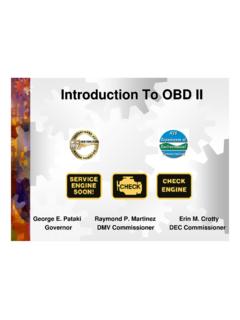Transcription of OM580-autophix20110921
1 OBDMATE om580 User s ManualENTEREXITHELPOBDMATEOM580 OBDII/EOBD1. Safety Precautions and WarningsTo prevent personal injury or damage to vehicles and/or the scan tool, read thisinstruction manual first and observe the following safety precautions at aminimum whenever working on a vehicle:Always perform automotive testing in a safe safety eye protection that meets ANSI clothing, hair, hands, tools, test equipment, etc. away from all moving orhot engine the vehicle in a well ventilated work area: Exhaust gases blocks in front of the drive wheels and never leave the vehicle unattendedwhile running extreme caution when working around the ignition coil, distributor cap,ignition wires and spark plugs. These components create hazardous voltageswhen the engine is the transmission in PARK (for automatic transmission) or NEUTRAL (formanual transmission) and make sure the parking brake is a fire extinguisher suitable for gasoline/chemical/electrical fires 't connect or disconnect any test equipment while the ignition is on or theengine is the scan tool dry, clean, free from oil/water or grease.
2 Use a milddetergent on a clean cloth to clean the outside of the scan tool, not attempt to operate or observe the tool while driving a or observing the tool will cause driver distraction and couldcause a fatal General On-Board Diagnostics (OBD) IIThe first generation of On-Board Diagnostics (called OBD I) wasdeveloped by the California Air Resources Board (CARB) andimplemented in 1988 to monitor some of the emission control componentson vehicles. As technology evolved and the desire to improve the On-Board Diagnostic system increased, a new generation of On-BoardDiagnostic system was developed. This second generation of On-BoardDiagnostic regulations is called "OBD II".The OBD II system is designed to monitor emission control systems andkey engine components by performing either continuous or periodic testsof specific components and vehicle conditions. When a problem isdetected, the OBD II system turns on a warning lamp (MIL) on the vehicleinstrument panel to alert the driver typically by the phrase Check Engine or Service Engine Soon.
3 The system will also store important informationabout the detected malfunction so that a technician can accurately find andfix the problem. Here below follow three pieces of such valuableInformation:1) Whether the Malfunction Indicator Light (MIL) is commanded 'on' or'Off';2) Which, if any, Diagnostic Trouble Codes (DTCs) are stored;3) readiness monitor Diagnostic Trouble Codes (DTCs)OBD II Diagnostic Trouble Codes are codes that are stored by the on-board computer diagnostic system in response to a problem found in thevehicle. These codes identify a particular problem area and are intended toprovide you with a guide as to where a fault might be occurring within avehicle. OBD II Diagnostic Trouble Codes consist of a five-digitalphanumeric code. The first character, a letter, identifies which controlsystem sets the code. The other four characters, all numbers, provideadditional information on where the DTC originated and the operatingconditions that caused it to be set.
4 Below is an example to illustrate thestructure of the digits:2 DTC ExampleP 0 5 2 0 SystemsB = BodyC = ChassisP = PowertrainU = NetworkLast two digits identify individualcomponent within the systemCode TypeGeneric (SAE):P0B0C0U0 Manufacturer Specific:P1, P2B1, B2C1, C2U1, U2 Sub-systems1 = Fuel and air metering2 = Fuel and air metering3 = Ignition system or engine misfire4 = Auxiliary emissions controls5 = Vehicle speed control and idle controls6 = Computer output circuits7 = Transmission controlsFigure 1-2: Explanation of a diagnostic trouble Location of the Data Link Connector (DLC)The DLC (Data Link Connector or Diagnostic Link Connector) is thestandardized 16-cavity connector where diagnostic scan tools interfacewith the vehicle's on-board computer. The DLC is usually located 12inches from the center of the instrument panel (dash), under or around thedriver's side for most vehicles.
5 If the Data Link Connector is not locatedunder the dashboard, a label should be there revealing its location. Forsome Asian and European vehicles, the DLC is located behind the ashtrayand the ashtray must be removed to access the connector. If the DLCcannot be found, refer to the vehicle's service manual for the 1-3: The DLC connector (left) can be found in the area ofthe car interior seen at right (black arrow). OBD II readiness MonitorsReadiness Monitors are indicators used to find out if all of the emissionscomponents have been evaluated by the OBDII system. They are runningperiodic tests on specific systems and components to ensure that they areperforming within allowable , there are eleven OBD readiness Monitors (or l/M Monitors)IIdefined by the Environmental Protection Agency (EPA). Not allmonitors are supported by all vehicles and the exact number of monitors inany vehicle depends on the motor vehicle manufacturer s emissionscontrol Monitors Some of the vehicle components or systems arecontinuously tested by the vehicle s OBD system, while others are testedIIonly under specific vehicle operating conditions.
6 The continuouslymonitored components listed below are always ready:1. Misfire2. Fuel System3. Comprehensive Components (CCM)Once the vehicle is running, the OBD system is continuously checkingIIthe above components, monitoring key engine sensors, watching forengine misfire, and monitoring fuel Monitors Unlike the continuous monitors, manyemissions and engine system components require the vehicle to beoperated under specific conditions before the monitor is ready. Thesemonitors are termed non-continuous monitors and are listed below:1. EGR System - exhaust Gas Recirculation for reducing greenhouse O2 Sensors - monitor and adjust air/fuel Catalyst - reduces exhaust Evaporative System - monitors the integrity of the fuel tank O2 Sensor Heater - brings O2 sensor to correct operating Secondary air - reduces exhaust Heated Catalyst - brings catalyst to correct operating A/C system - monitors system for freon that have been OBD II tested will be reported as OK.
7 Thepurpose of recording readiness status is to allow inspectors to determine ifthe vehicle s OBDII system has tested all the emissions systems. This ishandy to know before bringing vehicle to a state emissions testing powertrain control module (PCM) sets a monitor to OK after anappropriate drive cycle has been performed. The drive cycle that enables aMonitor and sets readiness codes to OK varies for each individualmonitor. Oncce a monitor is set as OK , it will remain in this state. Anumber of factors, including erasing of diagnostic trouble codes (DTCs)with a code reader or a disconnected battery, can result in ReadinessMonitors being set to INC (incomplete). Since the three continuousmonitors are constantly evaluating, they will be reported as OK all of thetime. As long as there are no DTCs stored in memory, the vehicle isrunning in accordance with the OBD II guidelines.
8 If testing of a particularsupportes non-continuous monitor has not been completed or not tested,the monitor status will be reported as INC (incomplete).In order for the OBD monitor system to become ready, the vehicle shouldbe driven under a variety of normal operating conditions. These operatingconditions may include a mix of highway driving and stop and go, city typedriving, and at least one overnight-off period. For specific information ongetting your vehicle s OBD monitor system ready, please consult yourvehicle owner s OBD II DefinitionsPowertrain Control Module (PCM) the OBD II terminology for the on-board computer that controls the engine and the drive Indicator Light (MIL) Malfunction Indicator Light (ServiceEngine Soon, Check Engine) is a term used for the light on the instrumentpanel. It is to alert the driver and/or the repair technician that there is aproblem with one or more of vehicle s systems and may cause emissionsto exceed federal standards.
9 If the MIL illuminates with a steady light, itindicates that a problem has been detected and the vehicle should beserviced as soon as possible. Under certain conditions, the dashboardlight will blink or flash. This indicates a severe problem and flashing OBD II monitor readiness StatusOBD II systems must indicate whether or not the vehicle s PCM smonitoring has completed testing on each emission Criteria Also termed Enabling Conditions. They are thevehicle-specific events of conditions that must occur within the enginebefore the various monitors will set, or run. Some monitors require thevehicle to follow a prescribed drive cycle routine as part of the enablingcriteria. Drive cycles vary among vehicles and for each monitor in anyparticular II Drive Cycle A specific mode of vehicle operation that providesconditions required to set all the readiness monitors applicable to thevehicle to the ready condition.
10 The purpose of completing an OBD II drivecycle is to force the vehicle to run its onboard diagnostics. Some form of adrive cycle needs to be performed after DTCs have been erased from thePCM s memory or after the battery has been disconnected. Runningthrough a vehicle s complete drive cycle will set the readiness monitorsso that future faults can be detected. Drive cycles vary depending on thevehicle and the monitor that needs to be reset. For vehicle specific drivecycle, consult the vehicle s Owner s Frame Data When an emissions related fault occurs, the OBD IIsystem not only sets a code, but also records a snapshot of the vehicleoperating parameters to help in identifying the problem. This set of valuesis referred to as Freeze Frame Date and may include important engineparameters such as engine RPM, vehicle speed, air flow, engine load, fuelpressure, fuel trim value, engine coolant temperature, ignition timingadvance, or closed loop to discourage vehicle operation.










